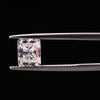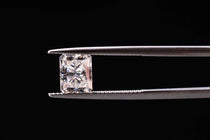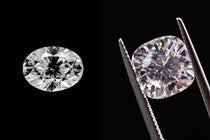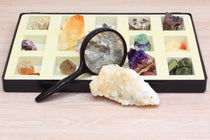When considering diamond cuts for engagement rings or other fine jewelry, oval and cushion cut diamonds are particularly popular choices. These two cuts each showcase the diamond's beauty in distinct ways, with unique characteristics that appeal to different tastes. Understanding the differences between oval and cushion cuts can help buyers make an informed decision when selecting the perfect diamond.
Oval cut diamonds feature a symmetrical, elongated shape that exudes elegance and sophistication. The gentle curves and elongated silhouette create the illusion of a larger stone, making them an appealing choice for those who seek an elongated appearance. Additionally, the oval cut's brilliant facets maximize light return, which can enhance a diamond's fire and brilliance.
Cushion cut diamonds, on the other hand, boast a classic, timeless appearance with distinctive rounded corners and larger facets. This cut originated centuries ago and has evolved over time, resulting in a variety of cushion shapes from square to rectangular. Its distinctive pillow-like shape lends a soft, romantic feel to the diamond, and the larger facets often display unique light patterns known as "fire" that showcase the stone's natural beauty.
Diamond Shapes Explained
| Shape | Description |
|---|---|
| Round Brilliant | The classic and most popular shape, known for its exceptional sparkle and fire. |
| Princess Cut | Square or rectangular with pointed corners, offering a modern and brilliant appearance. |
| Emerald Cut | Rectangular with cut corners and step-cut facets, emphasizing clarity and elegance. |
| Asscher Cut | Square emerald cut with a similar elegance and a vintage appeal. |
| Marquise Cut | Oval with pointed ends, creating an elongated and unique look. |
When choosing a diamond for an engagement ring or other jewelry, the shape of the diamond is an important factor to consider. Two popular diamond shapes are the oval and cushion cuts. Both shapes have their unique characteristics, and their differences are worth understanding.
The oval cut diamond is an elongated version of the classic round diamond. The oval shape has gained popularity due to its ability to create an illusion of a larger stone, while maintaining a high level of brilliance. This shape can also make the wearer's finger appear longer and slimmer. Oval cut diamonds are versatile, suitable for various designs such as solitaire, halo, and vintage settings. They are generally available in two length-to-width ratios: 1.33-1.66 (classic) and greater than 1.66 (elongated).
On the other hand, cushion cut diamonds, also known as pillow-cut diamonds, have rounded corners and larger facets, creating a soft, romantic look. This cut has been around for over 200 years, making it a timeless choice for those who appreciate vintage designs. Cushion cuts possess a unique sparkle, often referred to as a "crushed ice" appearance, due to the way light is dispersed through the facets. The emerald cut and radiant cut are similar to cushion cuts, but with a more rectangular shape.
When selecting between oval and cushion cut diamonds, personal preference plays a significant role. Some may be drawn towards the elongated shape and brilliance of an oval diamond, while others may prefer the vintage charm and unique sparkle of a cushion cut. No matter the choice, both shapes can create stunning, unforgettable pieces for life's most special moments.
Understanding Diamond Cuts

When it comes to diamond cuts, the oval cut and cushion cut are two popular options. The oval cut, a variation of the brilliant cut, has an elliptical shape that typically appears larger due to its longer silhouette. This cut showcases excellent brilliance and fire, making it a stunning choice for those desiring a unique yet classic diamond shape.
Cushion cut diamonds, on the other hand, feature a square or rectangular shape with rounded corners, resembling a pillow. Consequently, they are sometimes referred to as "pillow cut" diamonds. This cut has been around for centuries and has evolved with varied levels of brilliance. Some cushion cuts lean more towards the brilliant cut, while others maintain a more vintage appeal with larger facets and less intense sparkle.
Both oval cut and cushion cut diamonds can be found in varying proportions, which can greatly affect their overall appearance and brilliance. Moreover, the quality of the cut plays a crucial role in determining the diamond's beauty and value. A well-cut diamond will reflect light effectively, maximizing its fire and brilliance.
When making a decision between an oval cut and a cushion cut diamond, there are several factors to consider, including personal preference, desired style, and the intended setting for the diamond. Oval cut diamonds tend to appear more elongated and can make a finger look slimmer, while cushion cut diamonds provide a softer, more romantic look. Additionally, the choice between the two cuts may also depend on how much brilliance or sparkle is desired in the final piece.
In conclusion, both oval and cushion cut diamonds offer unique and attractive features. Ultimately, the decision between these popular diamond cuts comes down to individual taste and style. By understanding the characteristics of each cut, one can make an informed decision that best suits their needs.
Comparison of Oval and Cushion Cut Diamonds

When it comes to choosing an engagement ring, two popular choices for the diamond's shape are the oval cut and the cushion cut. Both shapes are elegant and timeless, but there are some key differences between them.
The oval cut diamond has an elongated shape that looks like an extended circle. This cut typically has 57 to 58 facets, allowing it to capture and reflect light efficiently. This brilliance often makes oval diamonds appear larger than their actual carat weight. Additionally, the elongated shape can have a slimming effect on the finger, making it a popular choice for those who want a ring that accentuates their hand's natural elegance.
| Characteristic | Oval Cut | Cushion Cut |
|---|---|---|
| Shape | Oval with rounded ends | Square or rectangular with rounded corners |
| Brilliance | Excellent brilliance due to its modified round shape. | Great brilliance, known for its fire and sparkle. |
| Face-up Size | Appears larger than a round diamond of the same carat weight. | Appears slightly smaller than an oval of the same carat weight. |
| Popularity | Among the most popular fancy diamond shapes. | Highly sought-after, especially in vintage and halo settings. |
| Setting Options | Versatile and complements various settings. | Suitable for vintage and halo settings. |
On the other hand, the cushion cut diamond has a square or rectangular shape, with rounded corners, resembling a pillow or cushion. This cut typically has 58 to 64 facets, giving it a unique balance between brilliance and fire. These factors make cushion cut diamonds sparkle in a slightly different way than oval cuts, featuring larger flashes of light and a distinctive pattern known as the "crushed ice" effect.
One of the main differences between the two cuts is the presence of a bowtie effect, or a dark band that may appear across the center of oval cut diamonds. Cushion cut diamonds do not have this effect. Some may find the bowtie effect appealing while others may prefer the more consistent light distribution found in cushion cut diamonds.
Another factor to consider when choosing between an oval and cushion cut is the shape of the wearer's finger. As mentioned previously, the elongated shape of the oval cut can create a slimming effect on the finger. In contrast, a cushion cut may be more suitable for those with shorter or wider fingers, as it can create the illusion of balance and proportion.
The process of selecting the perfect engagement ring involves personal preferences and desired aesthetics. Both oval cut moissanite and cushion cut moissanite diamonds offer unique advantages and beautiful designs, so it's essential to carefully consider which cut best fits the individual's style and preferences.
Cut Quality and Brilliance
Oval and cushion cut diamonds are popular choices for engagement rings and other jewelry. Both of these shapes exhibit unique characteristics, but their cut quality and brilliance are essential factors to consider when selecting a diamond.
An oval cut diamond features a standard number of facets, which enhances its brilliance and fire. Its elongated shape allows more light to pass through the stone, creating a brighter sparkle. This cut is designed to maximize the diamond's brilliance and create a more visually appealing effect. Additionally, its elongated shape can create the illusion of a larger stone and make the fingers appear slender.
Cushion cut diamonds, on the other hand, have a more vintage appeal and are often admired for their romantic aesthetic. These diamonds are characterized by their rounded corners and larger facets, which can increase the stone's brilliance. The cushion cut is able to disperse light effectively, generating a unique blend of brilliance and fire throughout the diamond. It is also worth mentioning that the clarity in cushion cut diamonds can sometimes be more visible than in oval cuts, so it is important to consider this factor when selecting a stone.
Both oval and cushion cut diamonds can display brilliance and fire, and the specific cutting technique plays a crucial role in determining these characteristics. The quality of the cut will affect the way light interacts with the diamond, ultimately defining its sparkle and fire. Therefore, it is essential to examine the diamond's proportions, symmetry, and polish when evaluating its cut quality.
In conclusion, the choice between an oval and a cushion cut diamond will largely depend on personal preference and style. While oval cut diamonds offer an elongated shape with increased brilliance, cushion cuts provide a more vintage appearance with a unique blend of brilliance and fire. Taking cut quality and brilliance into account will help ensure you select a diamond that meets your expectations and showcases the qualities you admire most.
Oval cut diamond ring for sale
Size and Carat Weight
When comparing oval and cushion cut diamonds, it is essential to consider the size and carat weight of the stones. The size of a diamond refers to its dimensions (length, width, and depth), while the carat weight measures the diamond's mass. Typically, 2 ct and 3 ct engagement rings are popular choices.
It is crucial to consider the face-up size of a diamond. The face-up size refers to how large the diamond appears from the top view, affecting how well it catches light and displays brilliance. Oval and cushion cut diamonds differ in their face-up size even when they have the same carat weight because of their shape and proportions. Oval diamonds have elongated shapes, generally appearing larger, whereas cushion cut diamonds have a more rounded square shape.
When assessing carat weight, remember that it does not always directly correspond to the face-up size. For example, a 1-carat oval cut diamond might have a larger surface area than a 1-carat cushion cut diamond. In such cases, the oval cut diamond will look bigger, even though both diamonds have the same carat weight.
Choosing between oval and cushion cut diamonds comes down to personal preference and understanding that size and carat weight might not always correlate. A higher carat weight diamond might not necessarily result in a larger face-up size. Evaluating the face-up size and the cut's overall impact on the diamond's appearance is key to finding the perfect engagement ring.
Clarity and Color
When comparing oval and cushion cut diamonds, clarity and color play significant roles in their overall appearance and value. Both these factors contribute to the diamond's brilliance and beauty, but their impact may vary due to the distinct characteristics of each cut.
In terms of clarity, diamonds are evaluated based on the presence of inclusions, flaws, or imperfections that can affect their light performance. These features are classified on a scale from Flawless (FL) to Included (I1, I2, I3), with higher grades representing diamonds with fewer or smaller inclusions. Oval cut diamonds, known for their elongated shape and distinctive brilliance, tend to hide inclusions better than cushion cuts. This means that an oval diamond might appear more visually appealing with slightly lower clarity grades, as imperfections are more likely to be concealed by the pattern of facets.
Cushion cut diamonds, on the other hand, possess a more balanced shape with a classic mix of round and square features, which can reduce the visual impact of inclusions. However, the larger facets in cushion cuts make it necessary to opt for a higher clarity grade, as inclusions can be more visible in these diamonds. In general, selecting a cushion cut diamond with a clarity grade of at least VS2 (Very Slightly Included) is recommended for an eye-clean appearance.
Color is another crucial aspect to consider when comparing oval and cushion cut diamonds. The color grade of a diamond ranges from D (colorless) to Z (light yellow or brown), with higher grades indicating less visible color. Due to their elongated shape, oval cut diamonds tend to show color more than cushion cuts. When selecting an oval diamond, it is advisable to choose a higher color grade (usually H or above) to ensure a whiter appearance.
Cushion cut diamonds, on the other hand, have a unique advantage when it comes to color retention. Their larger facets can produce a more even distribution of color, and the cut is known to enhance the appearance of natural hues. As a result, cushion cut diamonds can often appear more vibrant and colorful than their oval counterparts, even at lower color grades.
In conclusion, when evaluating oval and cushion cut diamonds in terms of clarity and color, it is essential to consider both the presence of inclusions and the perceived color in each cut. While oval cuts can hide inclusions more effectively, they tend to show more color. Cushion cuts, conversely, require higher clarity grades but can appear more vibrant and colorful even at lower color grades.
Cushion cut diamond ring for sale
Engagement Ring Settings
When choosing an engagement ring, one of the important decisions is the type of diamond cut. Both oval and cushion cut diamonds are popular choices for engagement rings. Each cut offers its own style and appearance, so it's essential to understand the differences between them and the settings that highlight their beauty.
Oval cut diamonds are elongated with a rounded edge, giving them a classic and elegant look. Their elongated shape can make fingers appear longer and more slender. Choosing the right setting for an oval cut diamond can enhance its natural beauty. A popular choice is the solitaire setting, which showcases the diamond as the center of attention. Additionally, a halo setting can add extra sparkle, surrounding the oval cut diamond with smaller stones.
On the other hand, cushion cut diamonds are known for their soft, rounded edges and slightly curved sides, resembling a pillow. This cut creates a romantic, vintage feel perfect for those who prefer a timeless, classic style. Like oval cut diamonds, solitaire and halo settings are popular choices for cushion cut diamonds. A solitaire setting emphasizes the diamond's unique shape, while a halo adds more brilliance, surrounding the center stone with smaller diamonds.
For those who prefer something more versatile, moissanite jewelry can be a great alternative to diamond engagement rings. Moissanite offers a similar sparkle and brilliance to diamonds but at a more affordable price. It can also be cut into various shapes and sizes, so couples can find an engagement ring that suits their personal style.
No matter which diamond cut or ring setting is chosen, the most important factor is finding a design that complements the wearer's taste and style. A well-chosen engagement ring can become a cherished symbol of love, commitment, and the unique bond shared between partners.
Choosing the Right Diamond Shape

When deciding between an oval and cushion cut diamond, several factors should be considered to ensure the perfect choice for your unique preferences and the wearer's finger shape. Both diamond shapes have their own distinct characteristics and benefits, which can help guide your decision.
Oval diamonds are known for their elongated shape and brilliant cut, which optimizes the reflection of light. This makes them appear larger and more radiant than other diamond shapes of a similar carat weight. Additionally, the elongated shape can create an illusion of a longer and more slender finger when worn as a ring, making it a flattering choice for various finger shapes.
On the other hand, cushion cut diamonds boast a classic and romantic look with their rounded corners and extensive facets. This shape is versatile and available in different proportions, ranging from square to rectangular, allowing customization to cater to personal preferences and finger shapes. While the cushion cut may not be as brilliant as the oval cut, it still provides ample sparkle and fire, making it an appealing choice for those who favor a more vintage appearance.
Both oval and cushion cut diamonds offer versatility when it comes to setting styles. While oval diamonds are often set as solitaire rings, they can be paired with side stones or intricate halo settings to further enhance the design. Similarly, cushion cut diamonds can be used as a center stone with a wide variety of setting options, such as bezel, prong, or pave settings, that accent their unique shape.
Ultimately, the decision between an oval and cushion cut diamond depends on personal preferences and the individual finger shape of the wearer. For those who prefer a diamond that presents a more brilliant and elongated look, the oval cut may be the right choice. Conversely, if a romantic and classic aesthetic is desired, a cushion cut diamond might be the perfect fit. By considering these factors, it is possible to choose the ideal diamond shape that will best suit the intended wearer, showcasing their beauty and personal style.
Popularity and Trends
| Diamond Shape | Popularity | Trends |
|---|---|---|
| Round Brilliant | Highly popular and timeless. | Continues to be a top choice for its classic appeal. |
| Princess Cut | Popular for its modern and brilliant appearance. | Often chosen in contemporary and halo settings. |
| Oval Cut | Increasing popularity due to its unique and elongated look. | Favored in solitaire and vintage-inspired settings. |
| Cushion Cut | Highly sought-after, especially for vintage and halo settings. | Known for its romantic and antique charm. |
| Emerald Cut | Growing popularity for its elegant and sophisticated style. | Often chosen in step-cut and minimalist settings. |
The popularity of diamond shapes often fluctuates due to consumer preferences and fashion trends. Oval and cushion cut diamonds, both known for their unique appearance, have gained considerable traction in recent years. The Top 20 Moissanite Engagement Rings 2022 collection showcases some stunning examples of these diamond cuts.
Renowned online diamond retailers, such as James Allen and Blue Nile, offer an extensive selection of both oval and cushion cut diamonds. These shapes have become popular choices for engagement rings for their elegance and soft edges. The versatility of these cuts allows them to suit various ring styles and settings, making them highly alluring to buyers.
One reason behind the rising popularity of oval diamonds is the elongated shape, which creates the illusion of a larger stone and makes the finger appear more slender. This flattering effect has contributed to the increased demand for oval cuts, especially in engagement rings.
Cushion cut diamonds, on the other hand, blend the classic appeal of a round brilliant with the distinct angular features of a square or rectangular shape. The softened corners add to their charm, providing a vintage feel which has captured the attention of modern brides. The Top 20 Moissanite Wedding Bands 2022 comprises a range of cushion cut diamonds embellishing wedding bands, exemplifying their timeless allure.
In conclusion, both oval and cushion cut diamonds have witnessed a surge in popularity due to their unique attributes and versatile nature, further propagated by well-established retailers like James Allen and Blue Nile. As consumers continue to value individuality and elegance in their jewelry choices, these diamond cuts are expected to retain their appeal in the foreseeable future.
Frequently Asked Questions
What are the main differences between oval and cushion cut diamonds?
Oval cut diamonds boast an elongated shape with curved edges and unique symmetry, creating a delicate and elegant appearance. Cushion cut diamonds, on the other hand, feature a square or rectangular shape with rounded corners, resembling a pillow. Cushion cuts typically showcase larger facets than oval cuts, giving them a more vintage look.
Do oval or cushion cut diamonds have better brilliance?
Both oval and cushion cut diamonds can have exceptional brilliance, but they showcase it differently. Oval cuts are known for their remarkable fire and brilliance due to their symmetrical facet pattern, reflecting light efficiently. Cushion cuts, with their larger facets, emphasize scintillation more – the flashes of light when the diamond moves. The overall brilliance would depend on the quality of the individual stone's cut.
Which cut makes a diamond appear larger: oval or cushion?
Oval cut diamonds tend to appear larger than cushion cuts of the same carat weight because of their elongated shape. The length of an oval cut can create an illusion of a more significant size. However, the perceived size of a diamond also depends on factors such as table size, depth, and overall proportions.
Are oval or cushion cut diamonds more expensive?
The pricing of diamonds depends on various factors like cut, color, clarity, and carat weight. While price differences between oval and cushion cut diamonds are not significant, oval cuts might sometimes have a higher price per carat due to the reduced rough diamond waste created during the cutting process. Additionally, oval cuts are increasingly popular, which may impact their pricing.
Which diamond cut is more suitable for engagement rings: oval or cushion?
Both oval and cushion cut diamonds are popular choices for engagement rings. The ideal cut for an engagement ring ultimately depends on personal preference and style. Oval cut diamonds have an elongated shape, which can flatter and elongate the wearer's finger. Cushion cuts exude a more vintage and romantic feel, making them an excellent choice for those who appreciate a classic look.
How do oval and cushion cuts compare in terms of durability and maintenance?
Oval and cushion cut diamonds generally possess good durability, but oval cuts might be slightly more prone to chipping due to their more exposed points. Regardless of the cut, it is crucial to take proper care of your diamond jewelry, including regular cleaning and professional inspection to ensure the setting remains secure.
Checkout some of our top collections:
- Moissanite Engagement Rings
- Moissanite Earrings
- Moissanite Bracelets
- Moissanite Solitaire Engagement Rings
- Moissanite Mens Engagement Rings
- Moissanite Princess Cut Stones
- Lab Grown Engagement Rings
- Lab Grown Diamond Earrings
- Lab Grown Diamond Wedding Bands









